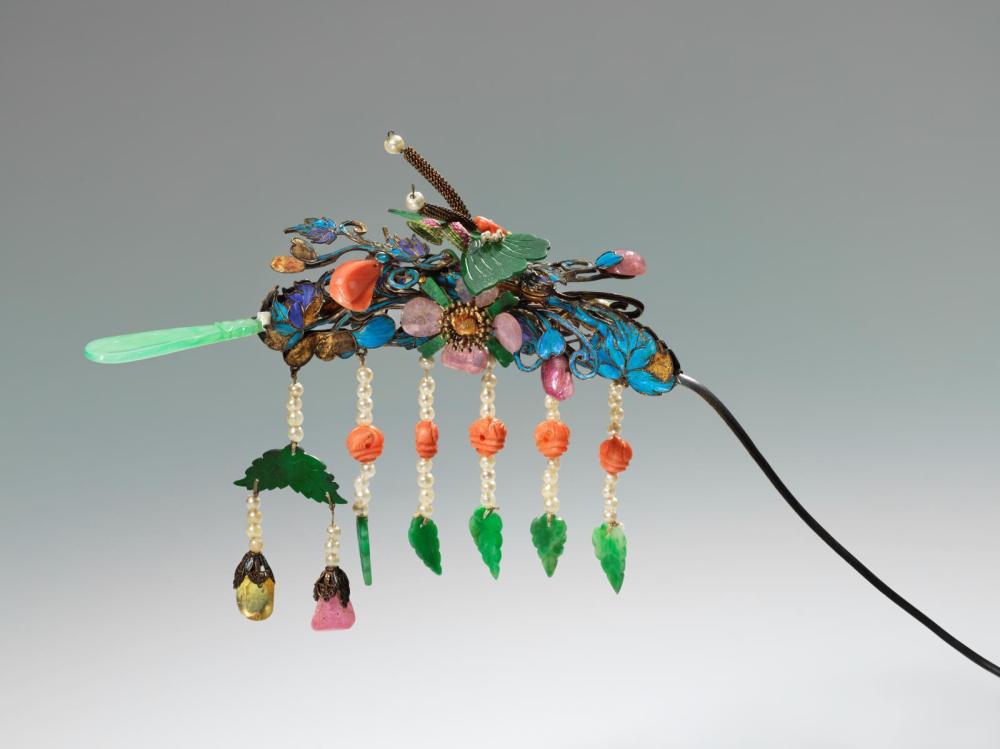Advanced Search 
Since the Han dynasty, kingfisher feathers have been used in China to decorate headdresses, hairpins, hair combs, and earrings, as well as bed hangings, screens, lanterns, and clothing. The inlaying of kingfisher feathers (點翠 diancui) became more popular during the Chinese Ming and Qing dynasties. The iridescent feathers were highly prized in the court and later among the larger population. The vibrant blue feathers were inlaid in the jewelry of aristocrats, noble ladies in court, and royalty. This technique is challenging and labor-intensive and reflects the histories and traditions of status and wealth. Similarly to cloisonné enamel, the feathers were applied with protein glue within a meticulously constructed metal framework forming auspicious symbols and motifs such as butterflies and peonies. Combined with semi-precious stones such as coral, jade, and pearls, the feathers produced a stunning visual effect. By the late 19th century, jewelry decorated with kingfisher feathers was also used in objects made in China for export to Europe and the Americas.

Hairpin
Chinese
19th century
Medium/Technique
Gilded metal, kingfisher feathers, semi-precious stones, imitation pearls, silk silk-wrapped wire
Dimensions
10.5 cm (4 1/8 in.)
Credit Line
William Sturgis Bigelow Collection
Accession NumberRES.11.4514
ClassificationsJewelry / Adornment
Since the Han dynasty, kingfisher feathers have been used in China to decorate headdresses, hairpins, hair combs, and earrings, as well as bed hangings, screens, lanterns, and clothing. The inlaying of kingfisher feathers (點翠 diancui) became more popular during the Chinese Ming and Qing dynasties. The iridescent feathers were highly prized in the court and later among the larger population. The vibrant blue feathers were inlaid in the jewelry of aristocrats, noble ladies in court, and royalty. This technique is challenging and labor-intensive and reflects the histories and traditions of status and wealth. Similarly to cloisonné enamel, the feathers were applied with protein glue within a meticulously constructed metal framework forming auspicious symbols and motifs such as butterflies and peonies. Combined with semi-precious stones such as coral, jade, and pearls, the feathers produced a stunning visual effect. By the late 19th century, jewelry decorated with kingfisher feathers was also used in objects made in China for export to Europe and the Americas.
ProvenanceBy 1911, purchased by William Sturgis Bigelow (b. 1850 - d. 1926), Boston [see note 1]; 1911, gift of Bigelow to the MFA. (Accession Date: August 3, 1911)
NOTES:
[1] Much of Bigelow's collection of Asian art was formed during his residence in Japan between 1882 and 1889, although he also made acquisitions in Europe and the United States. Bigelow deposited many of these objects at the MFA in 1890 before donating them to the Museum's collection at later dates.
NOTES:
[1] Much of Bigelow's collection of Asian art was formed during his residence in Japan between 1882 and 1889, although he also made acquisitions in Europe and the United States. Bigelow deposited many of these objects at the MFA in 1890 before donating them to the Museum's collection at later dates.
